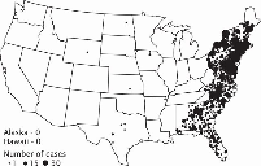Travel Reference
In-Depth Information
Figure 32-3. Rabies in raccoons, 1998 (2872 cases total)
Batrabiesisthoughttobetransmittedtohumansbybites,althoughbatteetharesosmall
and so sharp that bites go undetected, particularly when individuals are sleeping when the
bite occurs. Four infections have been spread by aerosols, two in laboratories and two in
Frio Cave near Uvalde, Texas. Only six of the thirty-seven individuals infected with rabies
of bat origin from 1990 to 2006 had a clear history of a bite by a bat, although two had
a history suggestive of a bat, and fifteen had reported physical contact with a bat. Eleven
individuals did not know of any contact with a bat.
TREATING THE BITE OF A RABID ANIMAL
Thetreatmentforrabies(immunoprophylaxis)isaracetodevelopprotectiveimmunitybe-
fore clinical infection appears. Treatment must be initiated at the time the bite is inflicted.
Therapy begun after the individual begins to show signs of rabies is ineffective.
The treatment of any animal bite has three components:
◆
Cleansing the bite wound
◆
Passive immunization with rabies immune globulin
◆
Active immunization with rabies vaccine
WithintheUnitedStates, iftheattacking animal isadomestic dog,cat,orferretthathas
been vaccinated for rabies within the past year and can be captured, it should be confined
under observation for ten days following the bite. If the animal is healthy at the end of that
time, it is safe to assume the animal did not have transmissible rabies at the time the bite
was inflicted, and immunotherapy is not required.
All other animals, including wolf hybrids, should be killed (euthanized) and their heads
shipped under refrigeration to a laboratory where the brain can be examined to determine
whether rabies virus is present. Public health services are responsible for maintaining reli-
able laboratories and for transporting the heads.
If the animal cannot be killed or captured, or if the encounter occurs in a developing
country, the animal must be assumed to be rabid regardless of the manner in which it was
behaving or whether it has been vaccinated. Rabies in animals follows a highly variable
course. The notorious “mad dog” foaming at the mouth is almost never seen. Unprovoked
attacks are the most common indication of rabies.

Search WWH ::

Custom Search